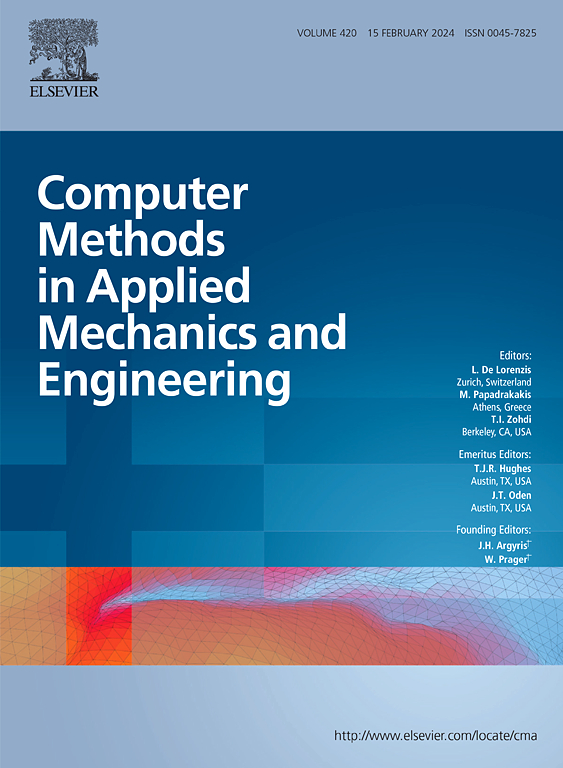Constrained or unconstrained? Neural-network-based equation discovery from data
IF 6.9
1区 工程技术
Q1 ENGINEERING, MULTIDISCIPLINARY
Computer Methods in Applied Mechanics and Engineering
Pub Date : 2025-01-01
DOI:10.1016/j.cma.2024.117684
引用次数: 0
Abstract
Throughout many fields, practitioners often rely on differential equations to model systems. Yet, for many applications, the theoretical derivation of such equations and/or the accurate resolution of their solutions may be intractable. Instead, recently developed methods, including those based on parameter estimation, operator subset selection, and neural networks, allow for the data-driven discovery of both ordinary and partial differential equations (PDEs), on a spectrum of interpretability. The success of these strategies is often contingent upon the correct identification of representative equations from noisy observations of state variables and, as importantly and intertwined with that, the mathematical strategies utilized to enforce those equations. Specifically, the latter has been commonly addressed via unconstrained optimization strategies. Representing the PDE as a neural network, we propose to discover the PDE (or the associated operator) by solving a constrained optimization problem and using an intermediate state representation similar to a physics-informed neural network (PINN). The objective function of this constrained optimization problem promotes matching the data, while the constraints require that the discovered PDE is satisfied at a number of spatial collocation points. We present a penalty method and a widely used trust-region barrier method to solve this constrained optimization problem, and we compare these methods on numerical examples. Our results on several example problems demonstrate that the latter constrained method outperforms the penalty method, particularly for higher noise levels or fewer collocation points. This work motivates further exploration into using sophisticated constrained optimization methods in scientific machine learning, as opposed to their commonly used, penalty-method or unconstrained counterparts. For both of these methods, we solve these discovered neural network PDEs with classical methods, such as finite difference methods, as opposed to PINNs-type methods relying on automatic differentiation. We briefly highlight how simultaneously fitting the data while discovering the PDE improves the robustness to noise and other small, yet crucial, implementation details.
受约束还是不受约束?基于神经网络的数据方程发现
在许多领域,从业者经常依靠微分方程来建模系统。然而,对于许多应用,这些方程的理论推导和/或其解的精确解析可能是棘手的。相反,最近开发的方法,包括基于参数估计、算子子集选择和神经网络的方法,允许在可解释性的范围内,以数据驱动的方式发现常微分方程和偏微分方程(pde)。这些策略的成功通常取决于从状态变量的嘈杂观察中正确识别代表性方程,同样重要的是,与此交织在一起的是用于执行这些方程的数学策略。具体来说,后者通常通过无约束优化策略来解决。将PDE表示为神经网络,我们建议通过解决约束优化问题并使用类似于物理信息神经网络(PINN)的中间状态表示来发现PDE(或相关算子)。该约束优化问题的目标函数促进了数据的匹配,而约束条件要求在多个空间搭配点上满足发现的PDE。提出了一种惩罚法和一种广泛使用的信任域障碍法来求解这一约束优化问题,并通过数值算例对这两种方法进行了比较。我们在几个示例问题上的结果表明,后一种约束方法优于惩罚方法,特别是对于更高的噪声水平或更少的并置点。这项工作促使人们进一步探索在科学机器学习中使用复杂的约束优化方法,而不是通常使用的惩罚方法或无约束方法。对于这两种方法,我们都使用经典的方法,如有限差分方法来求解这些发现的神经网络偏微分方程,而不是依赖于自动微分的pnas类型的方法。我们简要地强调了如何在发现PDE的同时拟合数据,从而提高对噪声和其他小而关键的实现细节的鲁棒性。
本文章由计算机程序翻译,如有差异,请以英文原文为准。
求助全文
约1分钟内获得全文
求助全文
来源期刊
CiteScore
12.70
自引率
15.30%
发文量
719
审稿时长
44 days
期刊介绍:
Computer Methods in Applied Mechanics and Engineering stands as a cornerstone in the realm of computational science and engineering. With a history spanning over five decades, the journal has been a key platform for disseminating papers on advanced mathematical modeling and numerical solutions. Interdisciplinary in nature, these contributions encompass mechanics, mathematics, computer science, and various scientific disciplines. The journal welcomes a broad range of computational methods addressing the simulation, analysis, and design of complex physical problems, making it a vital resource for researchers in the field.

 求助内容:
求助内容: 应助结果提醒方式:
应助结果提醒方式:


